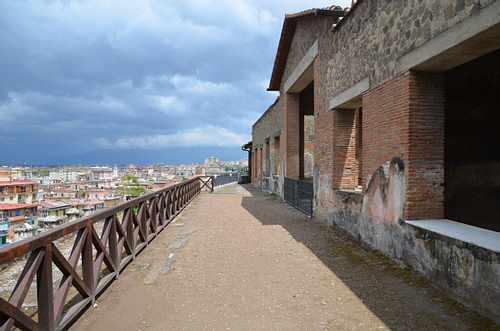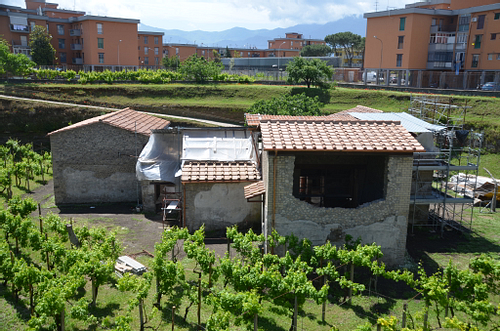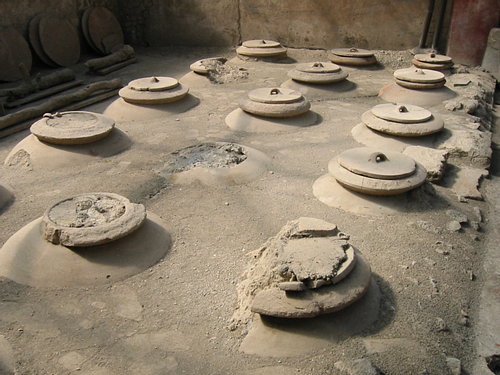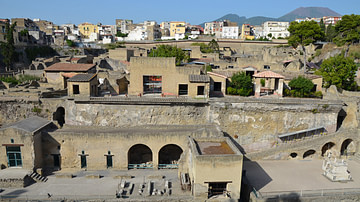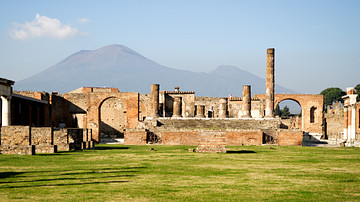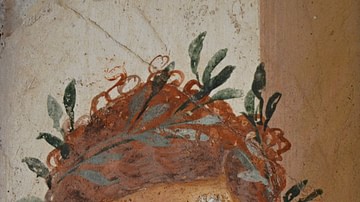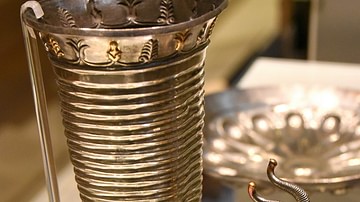More than 2,000 years ago, extremely wealthy Romans lived on the sunny shores of the Bay of Naples at Pompeii and in opulent villas nearby, unconcerned about Mount Vesuvius in the distance. Julius Caesar (100-44 BCE), Augustus (r. 27 BCE - 14 CE), Cicero (106-43 BCE), and Emperor Nero (r. 54-68 CE) were among the famous people who lived there. In 79 CE, Vesuvius erupted and destroyed towns and villas to the southeast of the volcano. While the impact was devastating, and many lives were lost, the eruption preserved a moment in Roman history.
In the first two parts of our travel series devoted to the archaeological sites around the Bay of Naples, we shared some tips on how you can prepare a self-guided tour of Pompeii and Herculaneum. In this third part, we will explore the magnificent Roman villas of Oplontis and Stabiae and visit the Antiquarium of Boscoreale with its rustic country villa, all buried in 79 CE by the Vesuvian eruption.

Although these three sites are included in the Pompeii three-day pass, they attract few visitors. However, they all deserve extra attention, and we hope that this guide will spur your interest in these off-the-beaten-track places.
Visiting Oplontis
The ancient seaside city of Oplontis (modern-day Torre Annunziata) is best known for the Roman Villa of Poppaea. It stood southeast of Vesuvius on a cliff twelve metres (40 ft) above the Mediterranean shoreline and was rumoured to belong to Roman emperor Nero's second wife, Poppaea Sabina (30–65 CE). The villa was severely damaged in an earthquake in 62 CE, and reconstruction work was still in progress during the eruption of Vesuvius. With its 100 rooms, sumptuous frescoes, and extensive gardens, Villa Poppaea is one of the most luxurious villas ever found in the Roman world. It was declared a World Heritage site by UNESCO in 1997 CE along with Pompeii and Herculaneum.
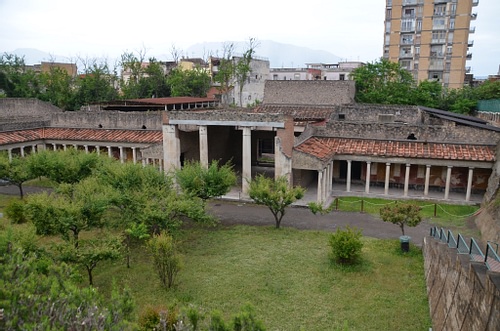
The visitor approaches the villa by walking down a long and deep staircase that reveals the volcanic ash depth beneath which the villa lay hidden for 1,500 years. This approach offers great views over the replanted north garden and the columned facade of the villa.
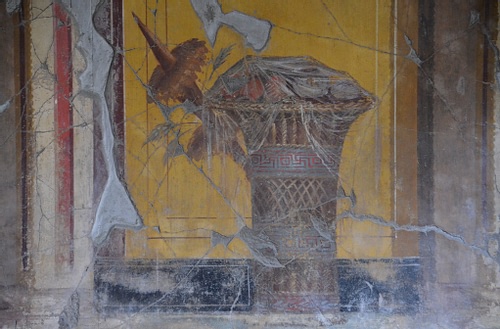
The villa seems to have undergone several phases of construction. The oldest part of the building dates back to about the middle of the 1st century BCE. It was organised around a Tuscan atrium with magnificent paintings in Second Pompeian Style with illusionistic depictions of architectural elements and views of landscapes. The villa overlooked the Bay of Naples to the south with a large peristyle and garden (viridarium) with porticoes to the north. Around the atrium were sumptuously decorated rooms for resting, dining, and sitting.
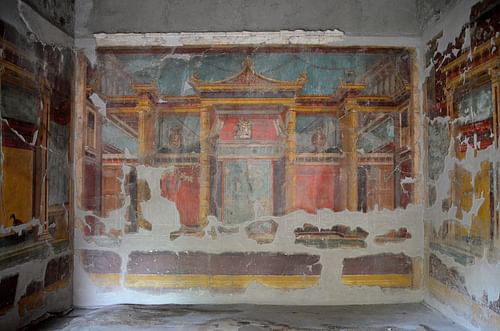
The complex was later extended to the east and extensively remodelled during the early Imperial Period. The new eastern wing consisted of elaborate reception and service rooms set around extensive gardens overlooking a 60-metre (197 ft) long swimming pool. The pool was flanked by marble statues and crater fountain vases which are now preserved in the Archaeological Museum of Naples.
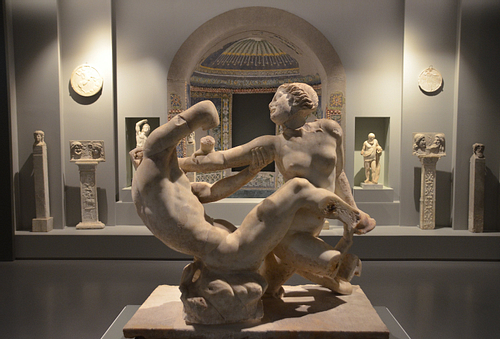
After the Vesuvius eruption, the villa lay for centuries beneath six-metre (20 ft) layers of lapilli (small stony particles) and ashes and then a thick layer of mud. It was first discovered in 1590 CE during the construction of the Sarno Canal which cut through the central hall of the villa. However, little was done at that time to explore the site further.
The excavations of the site restarted between 1839 and 1840 CE and were undertaken by Bourbon excavators. Due to lack of funds, work was again suspended, and it was not until the mid-1980s CE that systematic excavations finally started, uncovering about 60 per cent of the villa. More than 100 rooms have been excavated so far.
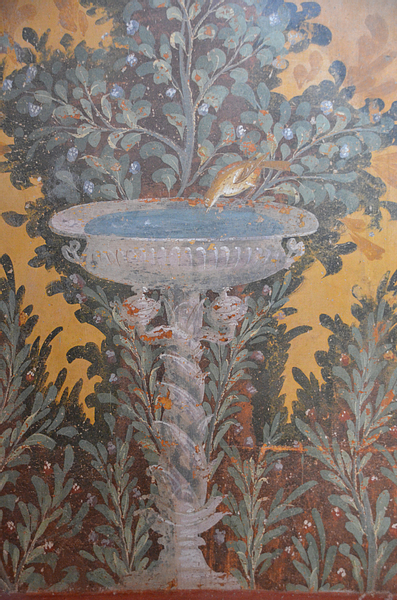
There is a second villa complex at Oplontis, but it is not currently open to visitors. The rustic villa of Lucius Crassius Tertius was most likely a horreum, a building in which commercial and production activities took place. It also had a housing area on the upper floor.
For more background information on the ancient villas at Oplontis visit the Oplontis Project website.
Visiting Stabiae
Located farther down the coast at the southern end of the Pompeian plain, ancient Stabiae (modern Castellammare di Stabia), was a small port with numerous luxurious villas. The town stood on the slopes of the Varano hill overlooking the sea and became a popular resort for wealthy Romans who desired to spend their summer away from Rome's unbearable heat.
At Stabiae, you can visit two villas, located above the modern town and with marvellous views over the bay. Villa Arianna was built in the 2nd century BCE and was named after a mythological fresco on the wall of its triclinium (formal dining room) depicting Dionysus' discovery of Ariadne on the island of Naxos.
The larger Villa San Marco, covering an area of 11,000 square metres (118,000 square feet), was built in the late 1st century BCE. It took its name from a chapel dedicated to Saint Mark (5-68 CE) that existed on the site in the 18th century CE. These luxury villas with porticoes and lavish gardens were filled with stunning artwork, and every wall, ceiling, and floor was decorated with beautiful frescoes and mosaics. Damaged in the earthquake of 62-63 CE, both villas were still being rebuilt in 79 CE.
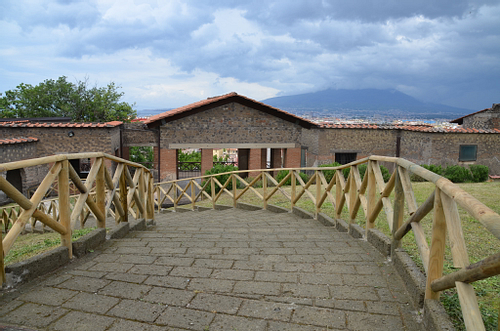
Villa Arianna was partially excavated in the 18th century CE by the Bourbon monarchy with explorations aimed at the discovery of its frescoes, mosaics, and most valuable furnishings. The villa was reburied after its structures had been surveyed and drafted. Excavations resumed in the 1950s CE, and in 2008 CE, a new round of excavations unearthed the large peristyle at the north end of the villa.
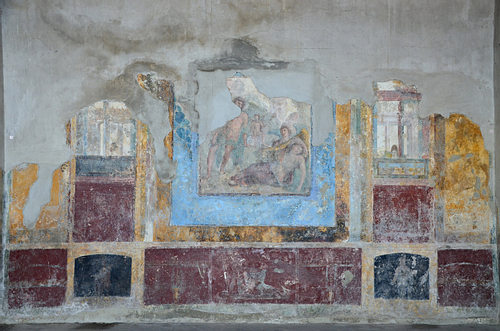
Villa Arianna shows a skillfully articulated layout that allowed its residential quarters to take advantage of the site location and enjoy the spectacular Gulf of Naples panorama. Built on a series of terraces over 150 years, the villa had four parts which were closely joined together: the atrium and the surrounding rooms dating back to the late Roman Republic (60-50 BCE); the service rooms and private baths added in the Augustan period (c. 43 BCE - 18 CE); the side rooms off the summer triclinium dating back to the Neronian Age (54-68 CE); and a large peristyle courtyard, added to the villa before the eruption of 79 CE. The villa also had stables and farm buildings and was connected to the shore through a ramp and tunnel.
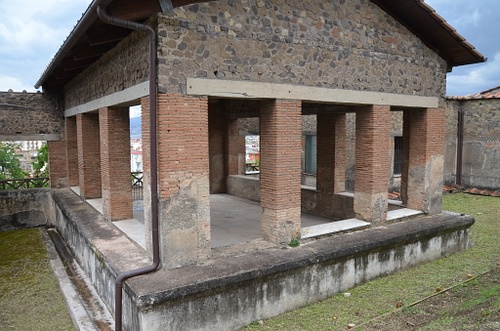
Some of the more precious wall paintings of Villa Arianna were removed during the Bourbon period (1814-1830 CE). They are now displayed together in the same room in the National Archaeological Museum of Naples and arranged according to the rooms where they were found.
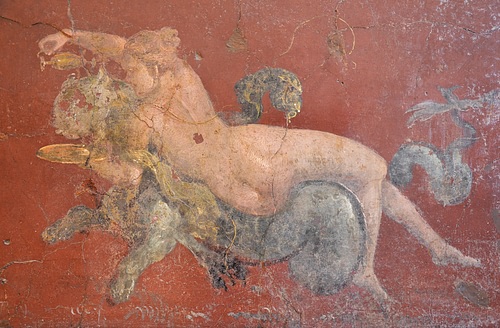
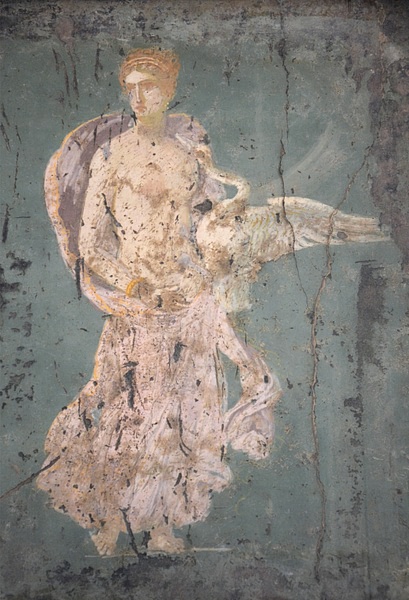
To the east of Villa Arianna are some rooms of a separate villa - "Arianna B". This second complex, separated from the Villa Arianna in Roman times by a narrow alley, was also explored and despoiled of much of its mosaic floors in Bourbon times. It presents a peristyle with a series of dining rooms overlooking the sea beyond which is the thermal zone.
The luxurious Villa San Marco is in a better state of preservation than Villa Arianna and is especially notable for being the largest villa ever discovered in Campania, although only half has been excavated. A modern stairway takes you five metres (16 ft) below the current street level to the entrance of the villa.
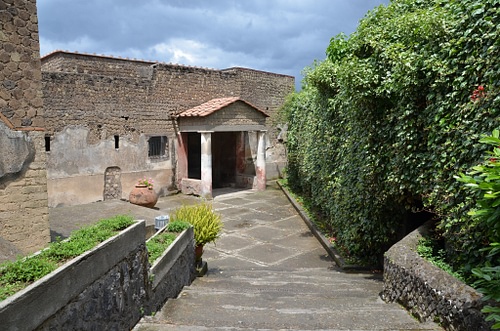
Construction of the villa started during the Augustan period and consisted of a few rooms centred around a square atrium and an adjacent large kitchen. It was later significantly extended to include a garden and swimming pool enclosed by collonaded porticoes.
The entrance to the villa leads to an atrium containing a pool (impluvium) surrounded by four Ionic columns, and a lararium (shrine to the household gods), adorned with frescoes imitating precious marbles. The atrium is decorated in the Fourth Pompeian Style with red, black, and yellow panels above a lower black frieze.

Located behind the atrium is a kitchen with a brick counter on which cooking took place and a series of small connecting rooms serving as storerooms. A corridor leads to a small but luxurious private bath complex centred around a small tetrastyle atrium. The baths originally had a frigidarium (cold bath), a caldarium (hot bath) heated by a bronze water-tank, a tepidarium (warm room), and perhaps an apodyterium (changing room).
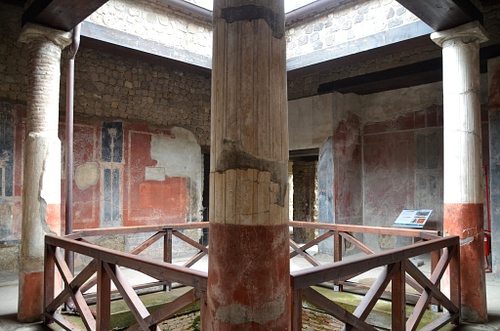
A doorway opens onto a monumental collonaded portico containing an elongated swimming pool, flanked by lines of plane trees. At the end of the pool is a nymphaeum embellished with niches decorated with mosaics and stucco and a central fountain. The walls of the portico are decorated in the Fourth Pompeian Style with red panels on black background above a lower black frieze and images of winged figures on the upper zone.

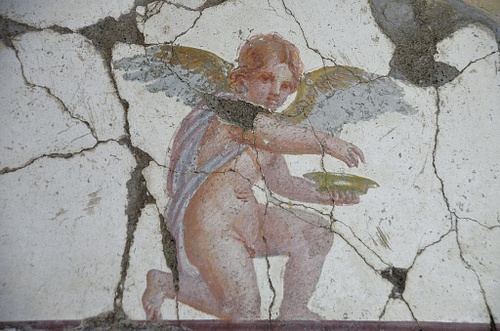
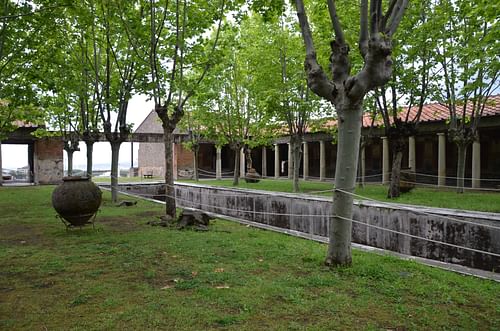
Fine paintings adorned the rooms located at each end of the side porticoes, many showing mythological scenes, including Perseus holding the head of Medusa, and Iphigenia, daughter of King Agamemnon.
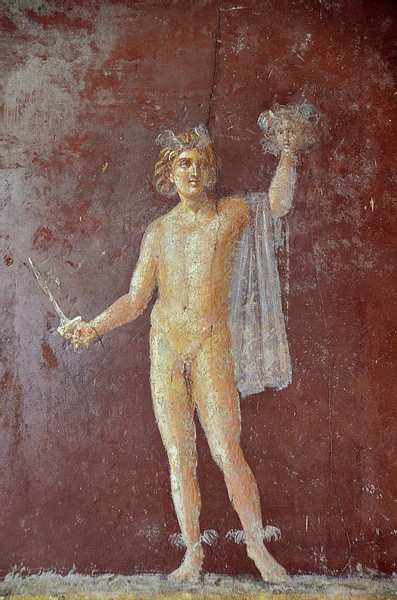
Beyond the swimming pool is part of a second larger portico with spiral-fluted columns. The ceiling of the portico was lavishly decorated with paintings depicting mythological scenes, such as the Planisphere of the Seasons and Phaethon and the Sun Chariot. Fragments of some of the frescoes were removed and put on display in the Antiquarium Stabiano, but the local museum has been closed since the late 1990s CE.
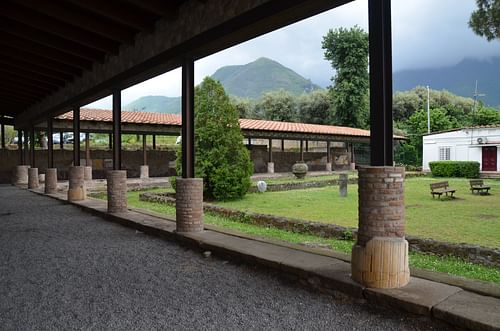
Like Villa Arianna, Villa San Marco was first excavated in Bourbon times in the 18th century CE and reburied after the removal of its furnishings and many of the better-preserved frescoes. The building was re-excavated 200 years later by Libero D'Orsi (1888-1977 CE), an Italian archaeologist, who brought to light some rooms of the villa with the help of the drawings made during the Bourbon excavations. Today, an ambitious Italian-American foundation project called 'Restoring Ancient Stabiae', has been excavating the rest of the town and its villas. The project is working on transforming the site into a large archaeological park.
The Museo Diocesano Sorrentino-Stabiese, located in the centre of Castellammare di Stabia, houses numerous finds from the recent archaeological excavations, including a milestone column of Emperor Hadrian (r. 117-138 CE), which attest to the recovery of the ancient city after the 79 CE Vesuvius eruption.
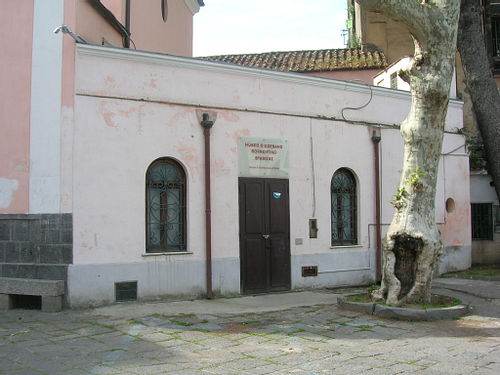
►DID YOU KNOW?
Departing from the Castellammare di Stabia train station, a cable car called the Funivia del Faito, gives you a panoramic ride to the top of Monte Faito. The Funivia cable car runs from 10:00 am until 5:00 pm daily from April through June and September through November; in July and August, it is open from 8:20 am until 8:10 pm (official website). The ride takes eight minutes. Tickets cost €8 (USD 8.60) roundtrip.
Visiting Boscoreale
The archaeological site of Boscoreale consists of a rustic country villa dating to the 1st century BCE and a fascinating antiquarium showcasing artefacts from Pompeii, Herculaneum, and the surrounding region.
Many archaeological excavations were carried out at Boscoreale between the late 19th century and early 20th century CE by private individuals, usually the landowners. Thanks to these excavations, about 30 farmhouses (villae rusticae) were located, providing a picture of the dense network of farmsteads operating on the lower slopes of Mount Vesuvius and the adjacent plain of the Sarno River. These working farms were generally family-run or managed by slaves and servants and they served adjacent towns. Some of the medium-sized rustic villas had lavishly decorated residential quarters designed to occasionally host the wealthy owner.
One of these farmhouses, Villa Regina, has been reconstructed and can be visited. It was built in the 1st century BCE and later enlarged. It was discovered in 1977 CE and has been preserved in its buried state 8 metres (26 ft) below ground level. According to the Boscoreale Antiquarium, this villa was used exclusively for wine production. This is shown by the presence of a wine press and a wine cellar with 18 partially buried terracotta jars (dolia) that were used to ferment and conserve the wine.
The Antiquarium, set up in 1991 CE, is located in a building adjacent to the archaeological site of Villa Regina. It is divided into two exhibition rooms. The first room is devoted to the economy and environment of the region in Roman times and showcases a copy of the famous plaster cast of a dog from Pompeii, and another of a domestic pig found in one of the Villa Regina's rooms. The second room displays some of the archaeological finds of the many villas excavated in the neighbourhood.
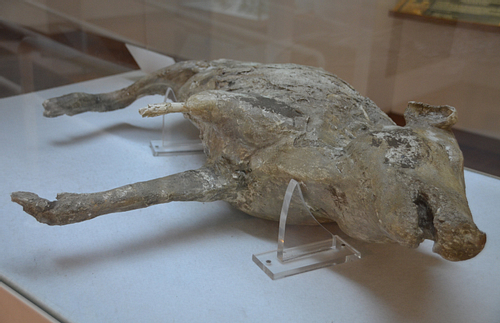
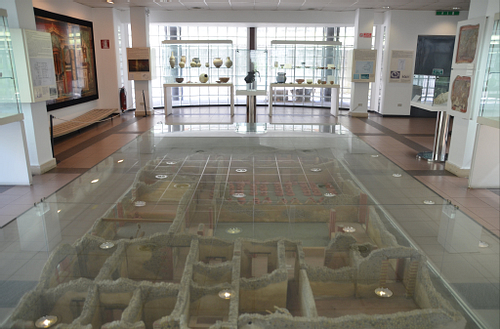
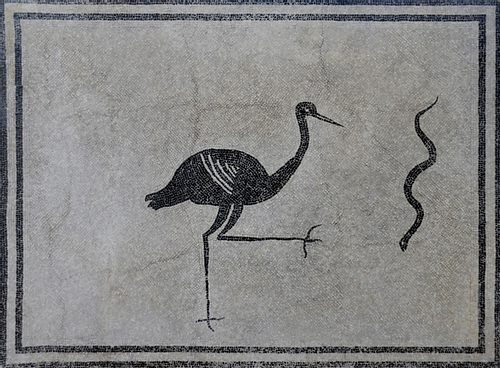
The excavations at Boscoreale produced many artefacts that were removed and sent to various museums around the world (such as the National Archaeological Museum of Naples, the Louvre Museum in Paris, and the Metropolitan Museum in New York). The most famous find was the Boscoreale Treasure, a remarkable hoard of silver and gold objects discovered in the Villa della Pisanella in 1895 CE.
The objects were hastily hidden by the owner at the beginning of the eruption of Vesuvius. They included 1,000 gold coins, jewellery, and 109 items of tableware found next to a man's skeleton. The Boscoreale treasure was purchased by the French financier Baron Edmond de Rothschild (1926-1997 CE) and given by him to the Louvre Museum in Paris.
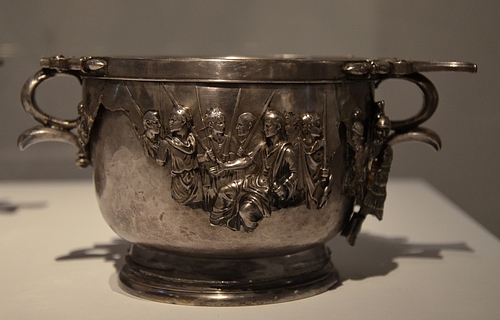
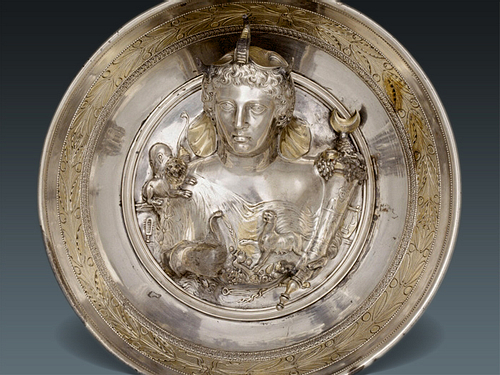
Oplontis, Stabiae and Boscoreale will appeal to both archaeology enthusiasts and tourists. A visit to these Roman villas offers a tantalising glimpse of the everyday life of Romans, and by discovering the impact of the Vesuvius eruption on the Roman people, we can better understand the plight of people impacted by natural disasters today.
How to Get There
Oplontis, Stabiae, and Boscoreale are located less than ten kilometres (six miles) from Pompeii. Oplontis is the easiest to reach as it is a 300-metre walk (980 feet) from Torre Annunziata Circumvesuviana train station along Via Sepolcri. By car, take the Torre Annunziata Sud exit from the Autostrada A3.
Boscoreale is also easily accessible on public transport by exiting the Circumvesuviana train at Villa Regina station. From the station, it is an easy 800 metres (0.5 miles) walk to the ruins and Antiquarium. Head north along Strada Statale 268 and Via Sattelermini, then turn left into Viale Villa Regina.
The site can also be reached on foot from the Villa dei Misteri entrance of Pompeii (if you wish to visit Boscoreale straight after Pompeii). It takes about 25 minutes and caution is needed while walking along Via Provinciale Andolfi (see directions here). By car, take the Torre Annunziata Sud exit from the Autostrada A3 if you are driving in the direction of Salerno or take the Boscoreale exit if you are driving in the direction of Naples.
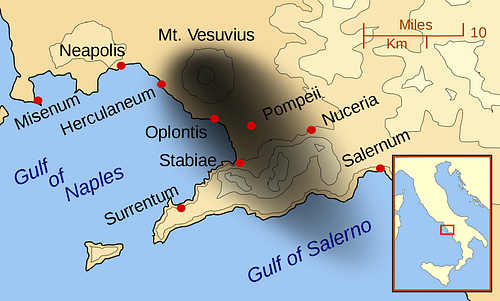
The ruins of Stabiae consist of two Roman villas located above the town of Castellammare di Stabia. However, they are more challenging to reach by public transport and walking to either site can be a pain, especially from the Castellammare di Stabia Circumvesuviana train station. We suggest instead to exit at the Via Nocera station for a relatively easy route on foot.
The first villa, Villa San Marco, is a 25-minute walk from Via Nocera station. Turn right after exiting the station and walk along Via Guiseppe Cosenza until you reach the motorway above the road. As you approach this junction, you will see the sign pointing to the archaeological sites. Walk along Strada Provinciale Varano Scavi di Stabia, and after a 15-minute walk, you will see a small sign for the site on your left. Continue walking along that road for a few minutes until you spot the 'entrance' sign.
To continue to Villa Arianna, go back to the main road and turn right. Walk along Passeggiata Archeologica for about 15 minutes until you see a yellow 'Archaeological Site' sign on your right. To return to the Via Nocera train station, head back toward Passeggiata Archeologica and turn right onto Strade Varano. Then make a sharp right turn onto Viale Puglia. At the first roundabout, take the first exit onto Viale Europa and at the second roundabout, take the first exit onto Via Giuseppe Cosenza.
By car, exit at Castellammare di Stabia on Autostrada A3, continue along SS145 (exit Gragnano) and via Passeggiata Archeologica. It takes a bit more effort to get to these sites, but you will experience these extraordinary villas with very few other visitors.
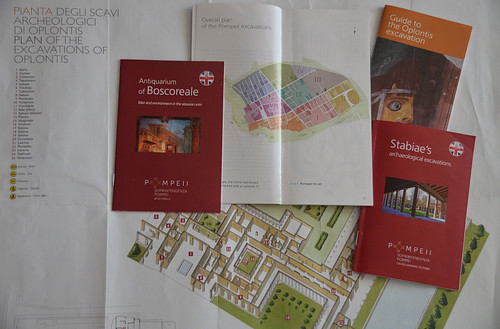
We would highly recommend you visit Villa Oplontis first and buy your three-sites combination ticket from the official ticket office at Oplontis. It includes Pompeii, Oplontis and Boscoreale and costs €18.00 (USD 19.50) at the time of writing.
Whenever you arrive at Oplontis, there will be no one else in line, so with your combo ticket, you can then skip the queue at Pompeii and go directly to the entry gates. A single ticket also covers Oplontis and Boscoreale. It costs €7.00 (USD 7.60), and it is valid for one day. The entry to the Stabiae ruins is free. Tickets can also be purchased online from the online ticketing service (TicketOne). For more information visit this website. You can also download PDF guides in advance of your trip here.
The sites are open every day except 1 January, 1 May, and 25 December. From 1 April to 31 October, the sites are open 09.00-19.30 (with last entrance at 18.00). Saturday and Sunday the sites open at 08.30. From 1 November to 31 March, the sites are open 09.00-17:30 (with last entrance at 15.30 and 16.00 for Boscoreale). Saturday and Sunday the sites open at 08.30, except Boscoreale.

